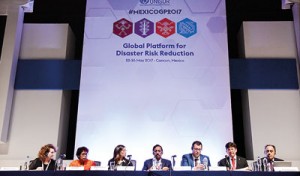News
Yapa waxes eloquent while disaster overwhelms ministry
View(s):While institutions under his purview were grappling feebly with the rising death and destruction from floods and landslides, Disaster Management Minister Anura Priyadharshana Yapa was in Mexico–talking about how Sri Lanka has put in place a programme to “minimise casualties, damage to infrastructure, and economic losses” in natural calamities.

Disaster Management Minister Anura Priyadharshana Yapa (fourth from left) 2017 Global Platform for Disaster Risk Reduction' in Cancun, Mexico
“The Ministry of Disaster Management has seriously considered the increasing trend of disasters and has collaborated with all ministries to implement medium and long-term disaster risk reduction programmes in line with the Sendai priorities, to minimise casualties, damage to infrastructure, and economic losses,” Mr Yapa said, attending the ’2017 Global Platform for Disaster Risk Reduction’ in Cancun, Mexico.
The conference was from May 22-26. The Minister spoke on May 24 and even posted a photo from the event on his Facebook page.
Meanwhile, back home, the Disaster Management Centre–which falls under Mr Yapa’s purview–was engaged in a desperate hunt for relief items. These included blankets, life jackets, mats, mobile toilets, tents, torches, towels, umbrellas, matchboxes, lighters, sanitary napkins, undergarments and rubber slippers. It had none of these in its stores.
The Sendai Framework for Disaster Risk Reduction 2015-2030 was adopted at the Third UN World Conference in Sendai, Japan, in March 2015. It envisages, among other things, the adoption of “a forward-looking and action-oriented” structure for disaster risk reduction. Sri Lanka is a signatory.
Minister Yapa said in his speech that, since the adoption of the Sendai Framework, his ministry has consulted relevant stakeholders and identified national targets, as well as prepared a National Action Plan.
“Sri Lanka has already taken measures to translate salient points of the Framework into our local languages, and conducted a series of awareness programmes at national and sub-national levels,” he said. “Our aim is to disseminate the key Sendai messages to the most-vulnerable, with specific focus to the school community.”
The Minister admitted that Sri Lanka, an island nation, faced “intensified challenges due to climate-related hazards”. “During the last two years, Sri Lanka has experienced devastating floods, landslides, and droughts,” he said. “Damage and economic losses caused by these disasters have exceeded US$ 1 billion.”
“After the devastating floods and landslides in May 2016, my Ministry led a Post-Disaster Needs Assessment (PDNA), which was supported by the World Bank, European Union, and United Nations to identify damage, losses and recovery needs,” he continued. “The figures uncovered by the PDNA were alarmingly high. The damage and losses exceeded US$ 660 million.”
“With the increase of unpredictable extreme weather events, these figures could be the new norm for countries such as ours,” he said. Sri Lanka has also established a “web-based damage and loss assessment system” and was now developing the next “National Disaster Risk Management Plan”.
“The Govt has also committed funds to develop risk profiles for frequently-occurring hazards, aiming to obtain risk information by 2020,” he said. There were challenges such as “inadequate capacity of development agencies on risk-sensitive development”. These could easily hamper our efforts in reducing disaster risks. He called for increased international cooperation for knowledge-sharing and capacity-building to achieve the Sendai targets.

